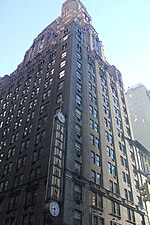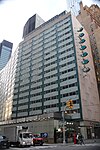Belmont Plaza Hotel
Defunct hotels in ManhattanLexington AvenueMidtown ManhattanUse American English from March 2024Use mdy dates from March 2024

Belmont Plaza Hotel was a hotel in New York City at 49th Street and 541-555 Lexington Avenue, across the street from the Waldorf Astoria.It was purchased by real estate developer and hotelier Alfred Kaskel in the fall of 1945. The Glass Hat Club at the Belmont was a popular supper club, where Dean Martin and Jerry Lewis were performing when they met in August 1944. In August 1964, the land on which the hotel was situated had been sold to the Massachusetts Mutual Life Insurance Company for $4.4 million, but that they leased it back immediately to Kaskel and his Belplaza Corporation.
Excerpt from the Wikipedia article Belmont Plaza Hotel (License: CC BY-SA 3.0, Authors, Images).Belmont Plaza Hotel
East 50th Street, New York Manhattan
Geographical coordinates (GPS) Address External links Nearby Places Show on map
Geographical coordinates (GPS)
| Latitude | Longitude |
|---|---|
| N 40.756111111111 ° | E -73.972222222222 ° |
Address
138 East 50th Street
East 50th Street 138
10022 New York, Manhattan
New York, United States
Open on Google Maps








